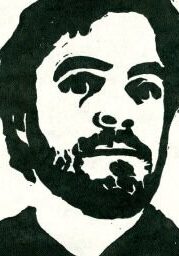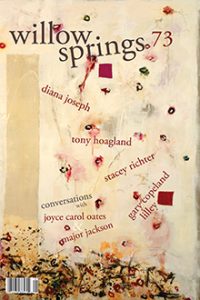
About Matthew Gavin Frank
Matthew Gavin Frank is the author of the nonfiction books Preparing the Ghost: An Essay Concerning the Giant Squid and Its First Photographer (forthcoming 2014 from W.W. Norton: Liveright), Pot Farm, and Barolo, the poetry books The Morrow Plots, Warranty in Zulu, and Sagittarius Agitprop, and the chapbooks Four Hours to Mpumalanga and Aardvark. He teaches creative writing in the MFA Program at Northern Michigan University, where he is Nonfiction Editor of Passages North. This winter, he prepared his first batch of whitefish liver ice cream. It paired well with onion bagels.
More Matthew Gavin Frank
Matthew Gavin Frank’s Homepage
Read an excerpt from Pot Farm (University of Nebraska Press).
Read an excerpt from Barolo (University of Nebraska Press).
Matthew Gavin Frank at Black Lawrence Press.
A Profile of the Author
Notes on “The Putting Down of the Mint Julep”
“The Putting Down of the Mint Julep” is part of a book in progress, tentatively titled, “Foood: 50 States, 50 Essays, 50 Recipes” (Yes: three Os). I’m hoping to stitch together this weird, lyrical, anti-cookbook cookbook of sorts. Each essay begins with a similar line of questioning, rooted in the state at hand, and its (perhaps strange) relationship to a particular food or drink often associated with said state: What does the mint julep mean? What does Kentucky mean? What ancillary subjects will I have to engage in order to grapple toward something that resembles an answer to these questions, however illusory and soft at the edges? Who will I have to uncover as interview subjects along the way? Sometimes, I’ll keep making phone calls and sending emails until I find someone who has worked at a bowling ball factory. Sometimes, the guy who worked at the bowling ball factory will serendipitously present himself, and redirect the essay in progress. So, the uncle in this piece is a composite character—one part my uncle, many parts other people’s uncles.
Oddly, many of these essays, even while having fun with form and digression, seem to gather peculiar little meditations on violence. It seems that if you scratch a state, you’ll find blood. If you scratch a beverage people like to drink while watching horses run really fast, you’ll find bone. To what degree is Kentucky at fault? To what degree is a specific breed of violence inherent in state “genetics,” in environment? To what degree does Kentucky’s ornamentation (the muddler, the sugar, the bowling pin, the horses on the television) impact the obsessions and moods of its inhabitants? Of course, when I sat down to cobble together a first draft of “Julep,” I had no idea as to the shape and trajectory of the essay; no idea what the fulcrum of the essay would look like, outside of Kentucky and Mint Julep—the springboards. When the ancillary subjects began attaching themselves, like burrs onto pant cuffs, to these springboards, the essay first became very expansive, until it had to be girdled in subsequent drafts. It’s so exciting when things like racehorse injuries and bowling ball names and ruined fingers and the implications inherent in crushing something to extract its best flavor begin to present themselves as viable digressive avenues, as stabs at some (illusory, soft-at-the-edges) truth.
I’m ever looking to find connections between seemingly dissimilar things in my work. How does the story of my first kiss relate to Alberto Santos-Dumont (the balloonist and dirigible pioneer) and locusts? I want to find out. I write essays, in part, to find such things out. Of course, we have allowed ourselves the power to manipulate connections between just about anything, via sufficient research, alchemy, contemplation . . . What is that perfect “bridge” ingredient that joins my lips, Dawn Liebermans’s lips, a blimp that ran on castor oil, and insectile plague? What does the archetypal first kiss have to do with flight, death? The journey to find out often embodies this weird, and addictive, bumping and grinding between moony incantation and mundane stakeout.
Notes on Reading
It’s funny: if I’m in New York City, by my third day there, I’ll start speaking with a New York accent. I may even start swaggering when I walk. If I’m in Memphis, I’ll be damned if by mid-week, I won’t start saying y’all. I know I’m not fooling anybody, yet I can’t help it. It’s almost malign how easily I succumb to particular strains of mimicry. Sometimes I feel like Zelig, from the Woody Allen movie. Certain books work on me that way, get into my bloodstream, affect not only the ways in which I’ll talk to my wife over dinner (both in choice of subject matter and diction), but also how I’ll kiss her goodnight, how I’ll plump my tongue, how I’ll blink against the pillowcase, what I’ll dream about afterward. Books work on me physically.
I often return to Norman Dubie’s poetry collection The Mercy Seat. I love Dubie’s poems for their drama, their characters, their social conscience, and their hilarity; how they combine the weirdest-ever lost episodes of PBS’s Nova with the joy inherent in the telling of a fabulously bad joke. I’ve been reading a lot of essay collections lately. “The Putting Down of the Mint Julep,” in its compulsion to interrogate, worships at the altar of Albert Goldbarth’s Many Circles. I remember reading Ander Monson’s Neck Deep and Other Predicaments a couple of years ago in my old backyard, and looking up from the page, bemused, as if I was now given the language necessary to crack the code in the patterns of bird shit on my car’s hood. After reading that book, I felt as if I understood the world a little bit better, or at least I was given permission for my confusion. Eula Biss’s Notes from No Man’s Land blows my mind every time I return to it. Elena Passarello’s Let Me Clear My Throat has its fingernails in me. That book, in examining the human voice via various lenses, exemplifies the dichotomy that lives in so many of my favorite essays: the sort of obsessive laser focus on a singular thing that compels the author to keep asking question after question about that thing, and the expansive subject matter attached to such singular meditations. Her essays breathe, send out feelers, and return to their sources a little more dazed than when they left. Passarello’s book stresses that in order to get at the center of the singular, we need multiple interrogations.
When I’m struggling with a piece, hitting a wall—when I feel like I have a poem or essay in my chest or the back of my throat that I need to dislodge, and it’s just not coming—I turn to my animal books, often the Audubon Field Guides to birds and fish. They almost always help me to shake something loose. There’s something about glossy bird or fish photos, their skeletal diagrams, their spectacular mating habits, that sets me to jotting something down.


